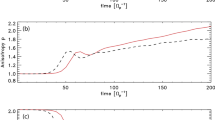Abstract
This paper provides a comprehensive analysis of the dynamics of the flow of minor ion species in the solar wind under the combined influences of gravity, Coulomb friction (with protons), rotational forces (arising from the Sun's rotation and the interplanetary spiral magnetic field) and wave forces (induced in the minor ion flow by Alfvén waves propagating in the solar wind). It is assumed that the solar wind can be considered as a proton-electron plasma which is, to a first approximation, unaffected by the presence of minor ions. In the dense hot region near the Sun Coulomb friction accelerates minor ions outwards against the gravitational force, part of which is cancelled by the charge-separation electric field. Once the initial acceleration has been achieved, wave and rotational forces assist Coulomb friction in further increasing the minor ion speed so that it becomes comparable with, or perhaps even exceeds, the solar wind speed. A characteristic feature of the non-resonant wave force is that it tends to bring the minor ion flow into an equilibrium where the radial speed matches the Alfvén speed relative to the solar wind speed, whereas Coulomb friction and rotational forces tend to bring the flow into an equilibrium where the radial speed of the minor ions equals the solar wind speed. Therefore, provided that there is sufficient wave energy and Coulomb friction is weak, the minor ion speed can be ‘trapped’ between these two speeds. This inteststing result is in qualitative agreement with observational findings to the effect that the differential flow speed between helium ions and protons is controlled by the ratio of the solar wind expansion time to the ion-proton collision time. If the thermal speeds of the protons and minor ions are small compared to the Alfvén speed, two stable equilibrium speeds can exist because the rapid decrease in the Coulomb cross-section with increasing differential flow speed allows the non-resonant wave force to balance Coulomb friction at more than one ion speed. However, it must be emphasized that resonant wave acceleration and/or strong ion partial pressure gradients are required to achieve radial speeds of minor ions in excess of the proton speed, since, as is shown in Section 4, the non-resonant wave acceleration on protons and minor ions are identical when their radial speeds are the same, with the result that, in the solar wind, non-resonant wave acceleration tends (asymptotically) to equalize minor ion and proton speeds.
Similar content being viewed by others
References
Alazraki, G. and Couturier P.: 1971,Astron. Astrophys. 13, 380.
Asbridge, J. R., Bame, S. J. and Feldman, W. C.: 1973,Trans. Am. Geophys. Union 54, 440.
Belcher, J. W.: 1971,Astrophys. J. 168, 509.
Bollea, D., Formisano, V., Hedgecock, D. C., Moreno, G. and Palmiotto, F.: 1972,Proc. Asilomar Solar Wind Conf., NASA SP-308, p. 588.
Bretherton, F. P. and Garrett, C. J. R.: 1968,Proc. Roy. Soc. London A302, 529.
Burgers, J. M.: 1969,Flow Equations for Composite Gases, Academic Press, New York and London.
Chang, S. C. and Hollweg, J. V.: 1976,J. Geophys. Res. 81, 1659.
Feldman, W. C., Asbridge, J. R., Bame, S. J. and Montgomery, M. D.: 1973,J. Geophys. Res. 78, 2017.
Formisano, V., Palmiotto, F. and Moreno, G.: 1970,Solar Phys. 15, 479.
Geiss, J., Hirt, P. and Leutwyler, H.: 1970,Solar Phys. 12, 458.
Goodrich, C. C.: 1978a, PhD. Thesis, M.I.T.
Goodrich, C. C.: 1978b, Private communication.
Hirshberg, J., Asbridge, J. R. and Robbins, D. E.: 1974,J. Geophys. Res. 79, 934.
Hollweg, J. W.: 1973a,Astrophys. J. 181, 547.
Hollweg, J. W.: 1973b,J. Geophys. Res. 78, 3643.
Hollweg, J. W.: 1974,J. Geophys. Res. 79, 1357.
Hollweg, J. V. and Turner, J. M.: 1978,J. Geophys. Res. 83, 97.
Hundhausen, A. J., Asbridge, J. R., Bame, S. J., Gilbert, H. E. and Strong, I. B.: 1967,J. Geophys. Res. 72, 1979.
Jocelyn, J. and Holzer, T.: 1978,J. Geophys. Res. 83, 1019.
McKenzie, J. F., Ip, W.-H. and Axford, W. I.: 1978,Nature 274, 350.
Neugebauer, M.: 1976,J. Geophys. Res. 81, 78.
Neugebauer, M. and Snyder, C. W.: 1966,J. Geophys. Res. 71, 4469.
Ogilvie, K. W. and Zwally, H. J.: 1972,Solar Phys. 24, 236.
Parker, E.: 1963,Interplanetary Dynamical Processes, Interscience Publishers, New York.
Richter, A. K. and Olbers, D. J.: 1974,Astrophys. Space Sci. 26, 95.
Rosenbauer, H.: 1977, Private communication
Ryan, J. M. and Axford, W. I.: 1975,J. Geophys. Res. 41, 221.
Völk, H. J. and Alpers, W.: 1973,Astrophys. Space Sci. 20, 267.
Yeh, T.: 1970,Planet. Space Sci. 18, 199.
Author information
Authors and Affiliations
Rights and permissions
About this article
Cite this article
McKenzie, J.F., IP, W.H. & Axford, W.I. The acceleration of minor ion species in the solar wind. Astrophys Space Sci 64, 183–211 (1979). https://doi.org/10.1007/BF00640041
Received:
Issue Date:
DOI: https://doi.org/10.1007/BF00640041




